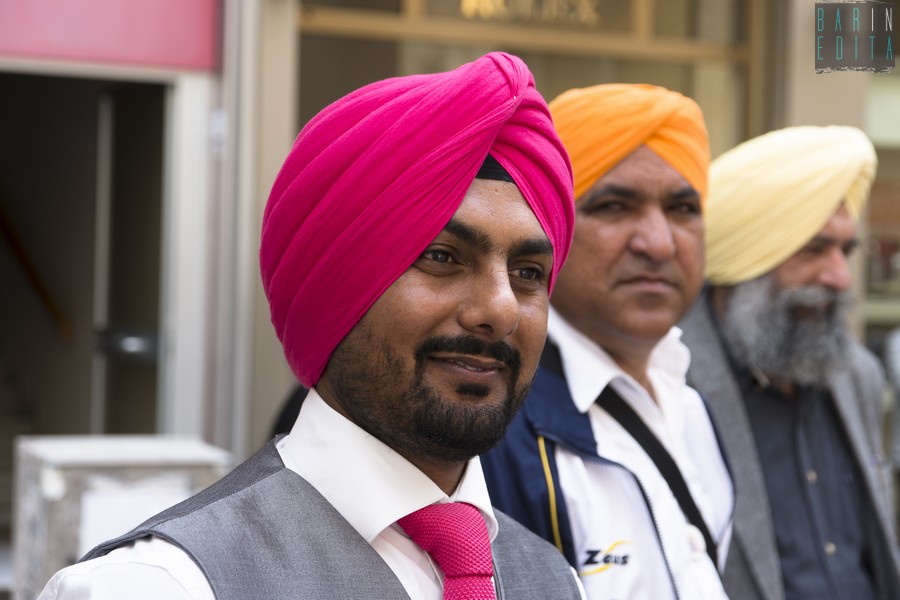Why do Sikhs wear turbans?

The turban is a distinct aspect of the Sikh identity, part of the traditional clothing and martial history of Sikhism. The turban has both practical and spiritual meaning. During the battle, the turban served as a flexible and breathable helmet that protects against arrows, bullets, mallets, spears and swords. He also kept the long hair of a Sikh away from his eyes and away from the grasp of an enemy. Modern turban advocates claim that it offers better protection than a motorcycle helmet.
Sikh dress code
All Sikhs must follow a code of conduct, which includes hair and head. A Sikh should keep all his hair intact and his head covered. The rule of dress for every Sikh man is to wear a turban. A Sikh woman can wear a turban or a traditional headscarf. A woman can also wear a scarf over a turban. Normally turbans are only removed in the most intimate circumstances, such as bathing the head or washing hair.
Spiritual meaning of covering hair
Sikhs must keep their hair in its natural, unaltered state known as kes. In addition to maintaining their hair, Sikh parents must keep their children's hair intact from birth onwards. Covering long hair with a turban helps protect it from getting tangled or coming into contact with pollutants, such as tobacco smoke. The Sikh code of conduct provides for abstention from tobacco use.
When a Sikh is initiated as Khalsa, or "pure", the nectar of amrit is sprinkled on the kes, and the initiates of Khalsa regard the kes as sacred from then on. Limiting the kes inside the turban frees the wearer from the social pressures of the dictates of fashion and allows the attention to focus internally on the adoration of the divine rather than externally on the superficiality.
Turbans to tie every day
Tying a turban is an event that occurs every morning in the life of a Sikh. Whenever the turban is removed, it must be carefully discarded so it never touches the floor, then shaken, stretched and bent in an orderly way to be ready for next use. The daily routine includes the care and cleaning of the kes and beard. Hair can also be combed and the turban can be retried after work, before evening prayers or before bedtime. Before tying a turban:
The kanga, a wooden comb, is used to untangle the kes and, if desired, oil is applied.
The kes is twisted into a joora, a knot or a coil on top of the head.
The kanga helps protect the joora and is always kept with the hair.
The keski, a protective length of cloth, is used by some Sikhs to cover and twist the joora, tying the hair on the top of the head.
Sikh men or women wearing keski often tie a second turban, or domalla, above the keski. A chunni is a long, light scarf worn by many Sikh women to cover their hair and can also be used to adorn a keski or turban. Many Sikh children wear a square piece of turban called a patka tied to their joora. They may have their kes intertwined before they are tied up to avoid tangling if their turban comes off while playing or while sleeping. Before bedtime an Amritdhari, or initiated Sikh, can choose to:
Sleep with a small turban tied over the joora
Cover a turban or keski on the head to cover the joora
Wear loose and draped kes with a small turban or keski
Braid the kes and drape your head with a small turban or keski
Turban styles
Style and color may reflect association with a particular group of Sikhs, a personal religious belief or even fashion. Turbans are available in many different styles, fabrics and colors. A longer turban is usually worn in a formal setting and can be coordinated according to the color of the occasion. The popular traditional colors of religious significance are blue, black, white and orange. Red is often worn for weddings. Patterned or tie dyed turbans are sometimes worn simply for fun. The veil or veil of a woman is traditionally coordinated with anything you wear and can be of a solid color or of contrasting colors. Many have decorative embroidery.
Turbans also come in a variety of light to heavy fabrics such as:
Mal Mal: A very light fabric
Voilea: a light texture
Rubia: a dense texture of medium weight
Turban styles include:
Domalla: double-length turban of 10 or more yards or meters
Pagriv: a double-width turban of five to six yards or meters
Dastar: a single turban of 4-6 yards or meters
Keski: a turban short of two or more yards or meters
Patka: a square from half to one meter or meter, tied above the joora and the head
Fifty: half a meter or meter worn under a turban, usually in contrasting or decorative colors
Scarf styles worn by Sikh women as headdresses include:
Chunni: a pure and light veil up to two and a half meters or meters, usually a solid color and can have embroidery
Dupatta: a double-width decorative veil up to two and a half meters, or meters, often embroidered on fabric of contrasting colors
Rumale: any square or triangular cloth worn as a headdress
Turban ornaments
Turbans can be adorned and embellished, simply or elaborately, to reflect the martial tradition of Sikhism:
A turban pin, including a khanda crest in plain steel, sarbloh iron covered with chrome or precious metals and encrusted with gems
Various representations of Shastar weapons, notably by throwing rings
Lengths of mala prayer beads in relief meditation
Chain mail fastened with steel cable
One or more miniature kirpans or ceremonial swords